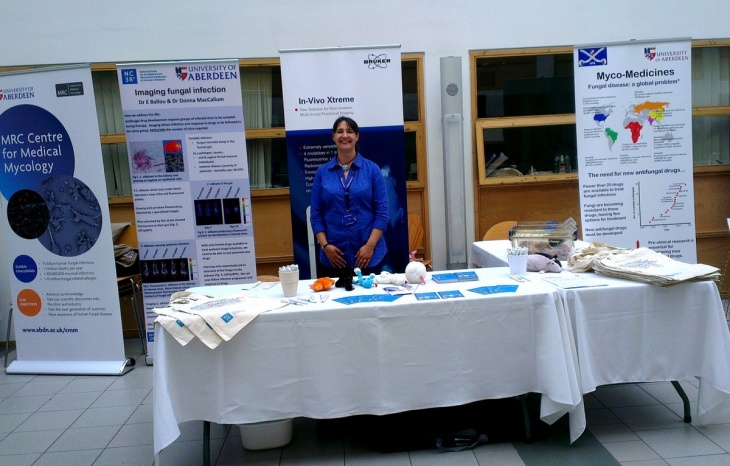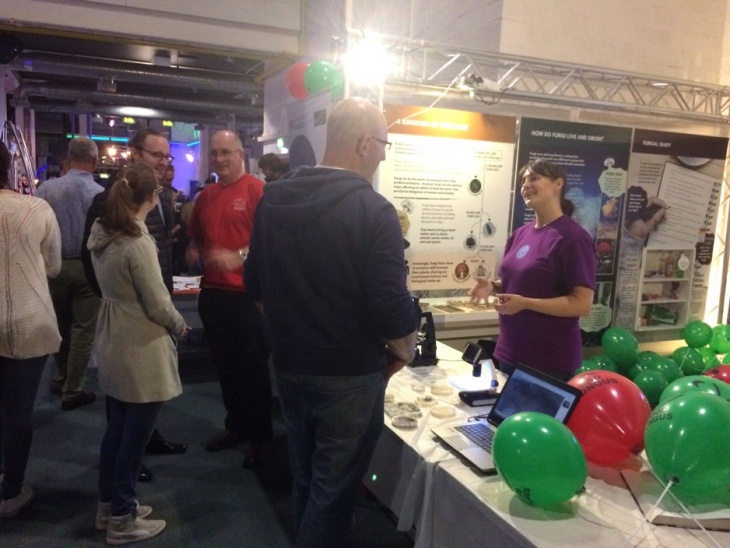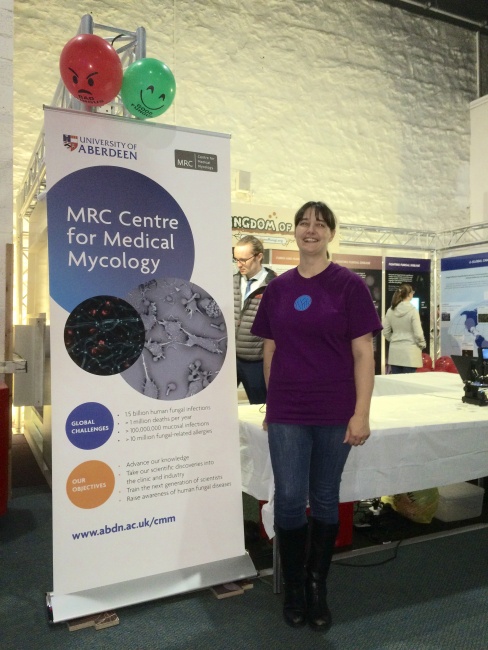
BSc (Hons) Genetics; PhD (Microbiology); PGCE (Higher Education Teaching); FHEA; FRSB
Reader and BSc Programme Lead
- Email Address
- d.m.maccallum@abdn.ac.uk
- Telephone Number
- +44 (0)1224 437425
- Telephone Number
- +44 (0)1224 437462
- Office Address
Aberdeen Fungal Group
Institute of Medical Sciences (Office 4.21)
University of Aberdeen
Foresterhill
Aberdeen
AB25 2ZD- School/Department
- School of Medicine, Medical Sciences and Nutrition
Biography
Current PhD students

PhD students Helen Heaney, Dora Corzo Leon, Ambre Chapuis, Stylianos Simantirakis, Dan Larcombe
Reviewing
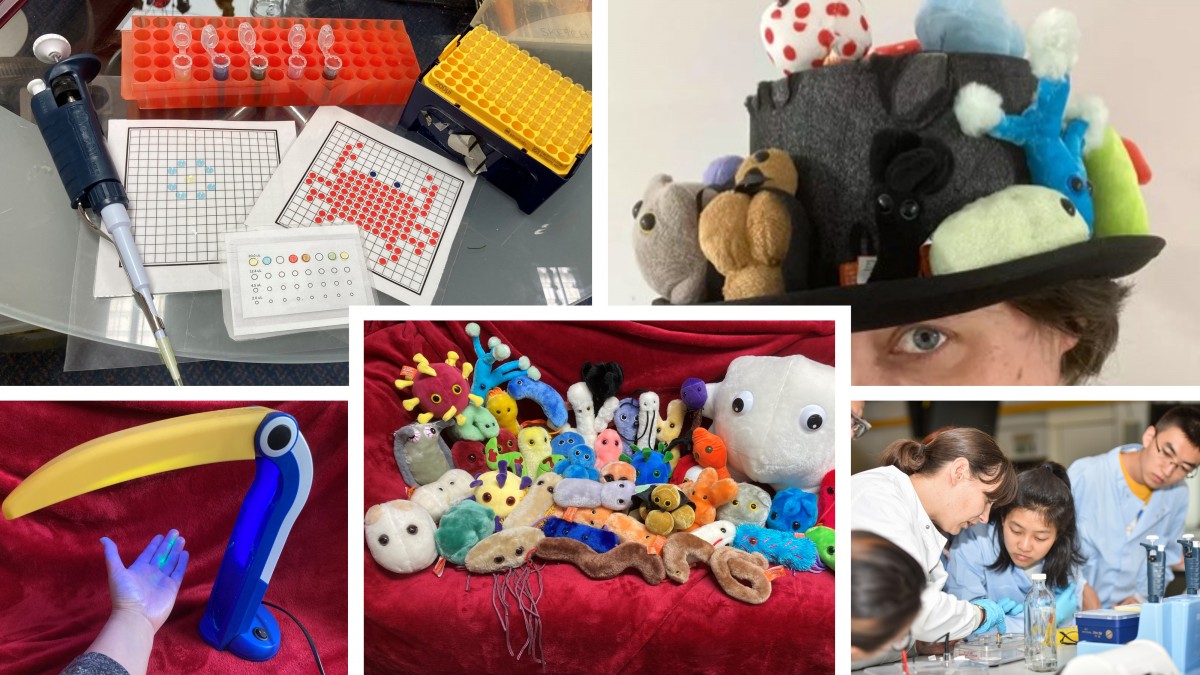
Public Engagement - STEM Ambassador
Donna MacCallum has been a registered STEM ambassador since 2012 and has carried out public engagement activities in nurseries, primary schools, secondary schools, science festivals and more...
Qualifications
- BSc Genetics (Honours)1994 - University of AberdeenFirst Class
- PhD Microbiology1999 - University of AberdeenmRNA differential display to investigate yeast-hypha dimorphism in Candida albicans
- PGCert Higher Education Teaching and Learning2004 - University of Aberdeen
- FHEA Education2007 - Higher Education Academy
- FRSB Biology2013 - Royal Society of Biology
Memberships and Affiliations
Latest Publications
Malassezia sympodialis Mala s 1 allergen is a potential KELCH protein that cross reacts with human skin
Corzo Leon, D. E., Scheynius, A., MacCallum, D. M., Munro, C. A.FEMS Yeast Research, vol. 23, foad028Contributions to Journals: ArticlesAn inclusive strategy to enhance equity and quality of research-led teaching experience
Kyle, J., Nath, M., MacCallum, D., Poobalan, A., Tucker, S.Contributions to Conferences: Oral PresentationsA Human Ex Vivo Skin Model to Study Candida auris Biofilms
Corzo-León, D. E., Mark, C., MacCallum, D. M., Munro, C. A.Methods in molecular biology (Clifton, N.J.), vol. 2517, pp. 259-267Contributions to Journals: Articles- [ONLINE] DOI: https://doi.org/10.1007/978-1-0716-2417-3_21
Mouse Gastrointestinal Colonization Model for Candida auris
Simantirakis, S. C., MacCallum, D. M.Methods in molecular biology (Clifton, N.J.), vol. 2517, pp. 329-340Contributions to Journals: Articles- [ONLINE] DOI: https://doi.org/10.1007/978-1-0716-2417-3_26
Blocking Polyphosphate Mobilization Inhibits Pho4 Activation and Virulence in the Pathogen Candida albicans
Ahmed, Y., Ikeh, M. A. C., MacCallum, D. M., Day, A. M., Waldron, K., Quinn, J.mBio, vol. 13, no. 3, e00342-22Contributions to Journals: Articles
Prizes and Awards
Honorary membership of the British Society for Medical Mycology (year)
Principal's Prize for Public Engagement (Public Prize) (year)
Research Overview
My research has centred on investigating fungal pathogenesis and virulence, focussing mainly on the opportunistic fungal pathogen Candida albicans and mouse models of infection. It also addresses the 3Rs: Replacement, Reduction and Refinement of animals in research, refining infection models and developing new ways to follow infection in animals.
Initially, my research focussed on investigating pathogenesis from the fungal perspective, using experimental infection models to assay the contribution of fungal gene products in virulence. I have also used microarray analyses to compare gene expression in known virulent and attenuated C. albicans clinical isolates, demonstrating that there are few differences under laboratory conditions (Eukaryotic Cell, 2009).
More recently, my research has extended into examining host responses, particularly immune responses, during infection in mice. By examining host responses to different C. albicans clinical isolates, I have demonstrated that low virulence isolates stimulate a lower innate immune response than more virulent isolates and that it is the early host response that determines infection outcome (PLoS One, 2009). A study to determine the early renal transcriptional response during progressive C. albicans infection confirmed the massive induction of innate immune responses (FEMS Yeast Research, 2009).
My major goal is to gain a better understanding of the factors leading to susceptibility to opportunistic fungal infections and to identify crucial events occurring during infection development, which could potentially allow identification of novel clinical management or therapeutic strategies for these infections.
Research Areas
Accepting PhDs
I am currently accepting PhDs in Biomedical Sciences.
Please get in touch if you would like to discuss your research ideas further.
Research Specialisms
- Medical Sciences
- Microbiology
- Animal Science
- Mycology
Our research specialisms are based on the Higher Education Classification of Subjects (HECoS) which is HESA open data, published under the Creative Commons Attribution 4.0 International licence.
Knowledge Exchange
Dr Donna MacCallum is very active in public engagement.
She has contributed school workshops, public lectures and family activities at the University of Aberdeen May Festival for each of the four years that the festival has run (https://www.abdn.ac.uk/mayfestival/).
She is a registered STEM ambassador (http://www.stemnet.org.uk/ambassadors/) and has carried out science workshops in schools. Most recently, she was successful in obtaining a Royal Society Partnership grant with Ms Amanda Kirk of Gilcomstoun Primary School, Aberdeen to carry out a resarch project to investigate whether household cleaners are effective again fungi (2016) (https://royalsociety.org/grants-schemes-awards/grants/partnership-grants/). She was also able to contribute towards Gilcomstoun Primary School's science activities, which contributed to their successful Primary Science Quality Mark Gold Award application (2016).
Dr MacCallum was also awarded one of the first National Centre for Replacement, Refinement and Reduction of Animals in Research (NC3Rs) public engagement awards (2016) to talk about how the University of Aberdeen are addressing the 3Rs in their life science research at Doors Open Day 2016 in the Institute of Medical Sciences, University of Aberdeen.
Dr MacCallum was also successful in being awarded the first Microbiology Society Microbiology in Society Awards (2016) in collaboration with University of Aberdeen Public Engagement Unit (PERU) and Aberdeen Science Centre to produce a new exhibit to explore the human gut microbiota.
Dr MacCallum has also been awarded a Microbiology Society Public Engagement Award (2010) to carry out "germ busting" with nursery children, where the children were shown effective handwashing and their technique was evaluated using UV lamps and fluorescent hand cream.
Dr MacCallum recently also designed and ran a Kids Zone workshop for the Killer Fungus exhibit at the Royal Society Summer Science Exhibition in London (2016) (https://royalsociety.org/science-events-and-lectures/summer-science-exhibition/).
She will be taking part in Explorathon 2016 at the Aberdeen Science Centre, explaining the resarch carried out in the Aberdeen Fungal Group at the Kingdom of Fungi exhibit (http://www.explorathon.co.uk/aberdeen/asc).
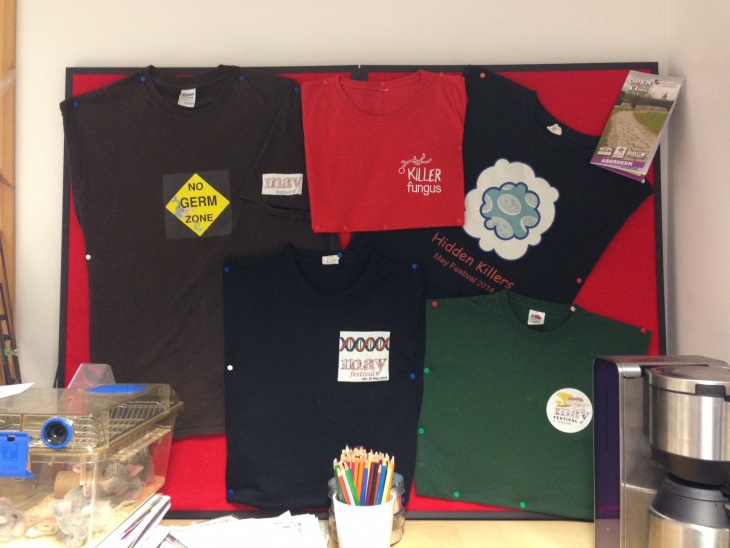
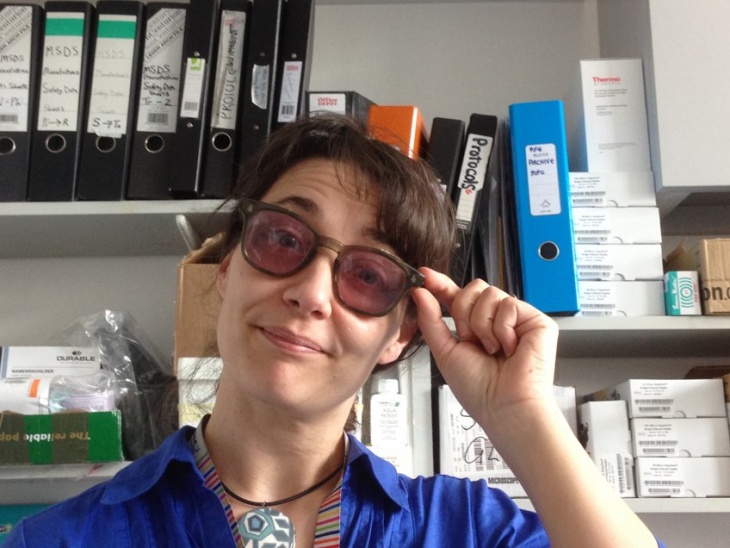
Supervision
My current supervision areas are: Biomedical Sciences.
Current Staff
- Ms. Hazel Bell (Technician)
Current PhD Students

PhD students: Helen Heaney, Dora Corzo Leon, Ambre Chapuis, Stelmos Simantirakis, Dan Larcombe at the Human Fungal Pathogen course in Nice, France.
- Mr Stylianos Simantirakis
- Ms Helen Heaney (Co-supervised by Dr Alan Walker and University of Exeter's Professor Al Brown)
- Mr Dan Larcombe (Co-supervised by University of Exeter's Professor Al Brown)
Completed PhD Students
- Dr Simon Vautier (co-supervised with Professor Gordon Brown) (2013)
- Dr Edina Szabo (primary supervisor) (2014)
- Dr Shane Smith (co-supervised with Dr Carol Munro) (2014)
- Dr Beatrice Achen (Main Supervisor: Professor Janet Quinn, Newcastle University) ()
- Dr Chibuike Ibe (Main supervisor: Professor Carol Munro) (2019)
- Dr Prashant Sood (Main supervisor: Professor Al Brown)
- Dr Ambre Chapuis (co-supervisor Dr Liz Ballou) (2020)
- Dr Dora Corzo Leon (co-supervisor Dr Carol Munro) (2020)
Programmes
- Postgraduate, 3 stage, September start
Programme Coordinator
- Postgraduate, 3 stage, January start
Programme Coordinator
Courses
Course Coordinator
Course Coordinator
Teaching Responsibilities
Postgraduate Teaching Academic Lead for the School of Medicine, Medical Sciences & Nutrition
Co-ordinator Roles
- MSc Microbiology Programme Coordinator (September and January start)
Undergraduate Teaching (lecturing)
- MC3504 Molecular Microbiology
- IM3502 Applied Immunology - Human Health
- Honours Immunology
- Honours Microbiology
- Honours Project Supervisor
Research Project Supervision
- BSc Honours project supervisor
- MSc/MRes Research Project supervisor
Non-course Teaching Responsibilities
Personal Tutor
Pastoral support for MSc students
University of Aberdeen Postgraduate Taught committee
University of Aberdeen Directors of Teaching and Learning Group
Page 4 of 5 Results 76 to 100 of 101
Carnitine-dependent transport of acetyl coenzyme A in Candida albicans is essential for growth on nonfermentable carbon sources and contributes to biofilm formation
Strijbis, K., van Roermund, C. W. T., Visser, W. F., Mol, E. C., van den Burg, J., MacCallum, D. M., Odds, F. C., Paramonova, E., Krom, B. P., Distel, B.Eukaryotic Cell, vol. 7, no. 4, pp. 610-618Contributions to Journals: Articles- [ONLINE] DOI: https://doi.org/10.1128/EC.00017-08
Candida albicans GRX2, encoding a putative glutaredoxin, is required for virulence in a murine model
Chaves, G. M., Bates, S., MacCallum, D. M., Odds, F. C.Genetics and Molecular Research, vol. 6, no. 4, pp. 1051-1063Contributions to Journals: Articles- [ONLINE] https://geneticsmr.com/articles/427
- [ONLINE] View publication in Scopus
Candida albicans GRX2, encoding a putative glutaredoxi, is required for virulence in a murine model
Chaves, G., Bates, S., MacCallum, D. M., Odds, F. C.Genetics and Molecular Research, vol. 6, no. 4, pp. 1051-1063Contributions to Journals: ArticlesDifferential regulation of the transcriptional repressor NRG1 accounts for altered host-cell interactions in Candida albicans and Candida dubliniensis
Moran, G. P., MacCallum, D. M., Spiering, M. J., Coleman, D. C., Sullivan, D. J.Molecular Microbiology, vol. 66, no. 4, pp. 915-929Contributions to Journals: Articles- [ONLINE] DOI: https://doi.org/10.1111/j.1365-2958.2007.05965.x
Candida Albicans: New Insights in Infection, Disease, and Treatment
MacCallum, D. M.New Insights in Medical Mycology. Kavanagh, K. (ed.). 1 edition. Springer, pp. 99-129, 31 pagesChapters in Books, Reports and Conference Proceedings: Chapters- [ONLINE] DOI: https://doi.org/10.1007/978-1-4020-6397-8_5
Niche-Specific Activation of the Oxidative Stress Response by the Pathogenic Fungus Candida albicans
Enjalbert, B. P., MacCallum, D. M., Odds, F. C., Brown, A. J. P.Infection and Immunity, vol. 75, no. 5, pp. 2143-2151Contributions to Journals: Articles- [ONLINE] DOI: https://doi.org/10.1128/IAI.01680-06
Multiple functions of DOA1 in Candida albicans
Kunze, D., MacCallum, D., Odds, F. C., Hube, B.Microbiology , vol. 153, no. 4, pp. 1026-1041Contributions to Journals: Articles- [ONLINE] DOI: https://doi.org/10.1099/mic.0.2006/002741-0
Peroxisomal fatty acid beta-oxidation is not essential for virulence of Candida albicans
Piekarska, K., Mol, E., van den Berg, M., Hardy, G., van den Burg, J., van Roermund, C., MacCallum, D. M., Odds, F., Distel, B.Eukaryotic Cell, vol. 5, no. 11, pp. 1847-1856Contributions to Journals: Articles- [ONLINE] DOI: https://doi.org/10.1128/EC.00093-06
Different consequences of ACE2 and SWI5 gene disruptions for virulence of pathogenic and nonpathogenic yeasts
MacCallum, D. M., Findon, H., Kenny, C. C., Butler, G., Haynes, K., Odds, F. C.Infection and Immunity, vol. 74, no. 9, pp. 5244-5248Contributions to Journals: Articles- [ONLINE] DOI: https://doi.org/10.1128/IAI.00817-06
Niche-specific regulation of central metabolic pathways in a fungal pathogen
Barelle, C., Priest, C. L., MacCallum, D. M., Gow, N. A. R., Odds, F. C., Brown, A. J. P.Cellular Microbiology, vol. 8, no. 6, pp. 961-971Contributions to Journals: ArticlesGlycosylphosphatidylinositol-anchored proteases of Candida albicans target proteins necessary for both cellular processes and host-pathogen interactions
Albrecht, A., Felk, A., Pichova, I., Naglik, J. R., Schaller, M., de Groot, P., MacCallum, D. M., Odds, F. C., Schäfer, W., Klis, F., Monod, M., Hube, B.The Journal of Biological Chemistry, vol. 281, no. 2, pp. 688-94Contributions to Journals: Articles- [ONLINE] DOI: https://doi.org/10.1074/jbc.M509297200
Functional analysis of the phospholipase C gene CaPLC1 and two unusual phospholipase C genes, CaPLC2 and CaPLC3, of Candida albicans
Kunze, D., Melzer, I., Bennett, D., Sanglard, D., MacCallum, D. M., Nörskau, J., Coleman, D. C., Odds, F. C., Schäfer, W., Hube, B.Microbiology , vol. 151, no. 10, pp. 3381-94Contributions to Journals: Articles- [ONLINE] DOI: https://doi.org/10.1099/mic.0.28353-0
Temporal events in the intravenous challenge model for experimental Candida albicans infections in female mice
MacCallum, D. M., Odds, F. C.Mycoses, vol. 48, no. 3, pp. 151-61Contributions to Journals: Articles- [ONLINE] DOI: https://doi.org/10.1111/j.1439-0507.2005.01121.x
Granulocytes govern the transcriptional response, morphology and proliferation of Candida albicans in human blood
Fradin, C., De Groot, P., MacCallum, D. M., Schaller, M., Klis, F., Odds, F. C., Hube, B.Molecular Microbiology, vol. 56, no. 2, pp. 397-415Contributions to Journals: Articles- [ONLINE] DOI: https://doi.org/10.1111/j.1365-2958.2005.04557.x
Mnt1p and Mnt2p of Candida albicans are partially redundant alpha-1,2-mannosyltransferases that participate in O-linked mannosylation and are required for adhesion and virulence
Munro, C. A., Bates, S., Buurman, E. T., Hughes, H. B., MacCallum, D. M., Bertram, G., Atrih, A., Ferguson, M. A., Bain, J. M., Brand, A. C., Hamilton, S., Westwater, C., Thomson, L. M., Brown, A. J. P., Odds, F., Gow, N. A. R.The Journal of Biological Chemistry, vol. 280, pp. 1051-1060Contributions to Journals: Articles- [ONLINE] DOI: https://doi.org/10.1074/jbc.M411413200
Efficacy of caspofungin and voriconazole combinations in experimental aspergillosis
MacCallum, D. M., Whyte, J. A., Odds, F. C.Antimicrobial Agents and Chemotherapy, vol. 49, pp. 3697-3701Contributions to Journals: Articles- [ONLINE] DOI: https://doi.org/10.1128/AAC.49.9.3697-3701.2005
Need for early antifungal treatment confirmed in experimental disseminated Candida albicans infection
MacCallum, D. M., Odds, F. C.Antimicrobial Agents and Chemotherapy, vol. 48, no. 12, pp. 4911-4914Contributions to Journals: Articles- [ONLINE] DOI: https://doi.org/10.1128/AAC.48.12.4911-4914.2004
Loss of cell wall mannosylphosphate in Candida albicans does not influence macrophage recognition
Hobson, R. P., Munro, C. A., Bates, S., MacCallum, D. M., Cutler, J. E., Heinsbroek, S. E. M., Brown, G. D., Odds, F. C., Gow, N. A. R.The Journal of Biological Chemistry, vol. 279, pp. 39628-39635Contributions to Journals: Articles- [ONLINE] DOI: https://doi.org/10.1074/jbc.M405003200
Ectopic expression of URA3 can influence the virulence phenotypes and proteome of Candida albicans but can be overcome by targeted reintegration of URA3 at the RPS10 locus
Brand, A. C., MacCallum, D. M., Brown, A. J. P., Gow, N. A. R., Odds, F. C.Eukaryotic Cell, vol. 3, no. 4, pp. 900-909Contributions to Journals: Articles- [ONLINE] DOI: https://doi.org/10.1128/EC.3.4.900-909.2004
The Candida albicans CaACE2 gene affects morphogenesis, adherence and virulence
Kelly, M. T., MacCallum, D. M., Clancy, S. D., Odds, F. C., Brown, A. J. P., Butler, G.Molecular Microbiology, vol. 53, no. 3, pp. 969-983Contributions to Journals: Articles- [ONLINE] DOI: https://doi.org/10.1111/j.1365-2958.2004.04185.x
GFP as a quantitative reporter of gene regulation in Candida albicans
Barelle, C., Manson, C. L., MacCallum, D. M., Odds, F. C., Gow, N. A. R., Brown, A. J. P.Yeast, vol. 21, no. 4, pp. 333-340Contributions to Journals: Articles- [ONLINE] DOI: https://doi.org/10.1002/yea.1099
Safety aspects of working with Candida albicans-infected mice
MacCallum, D. M., Odds, F. C.Medical Mycology, vol. 42, no. 4, pp. 305-309Contributions to Journals: Articles- [ONLINE] DOI: https://doi.org/10.1080/13693780310001601092
The Candida albicans pH-regulated KER1 gene encodes a lysine/glutamic-acid-rich plasma-membrane protein that is involved in cell aggregation
Galan, A., Casanova, M., Murgui, A., MacCallum, D. M., Odds, F. C., Gow, N. A. R., Martínez, J. P.Microbiology , vol. 150, no. Pt 8, pp. 2641-2651Contributions to Journals: Articles- [ONLINE] DOI: https://doi.org/10.1099/mic.0.26339-0
Influence of grapefruit juice on itraconazole plasma levels in mice and guinea pigs
MacCallum, D. M., Odds, F. C.Journal of Antimicrobial Chemotherapy, vol. 50, no. 2, pp. 219-224Contributions to Journals: Articles- [ONLINE] DOI: https://doi.org/10.1093/jac/dkf103
Efficacy of parenteral itraconazole against disseminated Candida albicans infection in two mouse strains
MacCallum, D. M., Odds, F. C.Journal of Antimicrobial Chemotherapy, vol. 50, no. 2, pp. 225-229Contributions to Journals: Articles- [ONLINE] DOI: https://doi.org/10.1093/jac/dkf072

